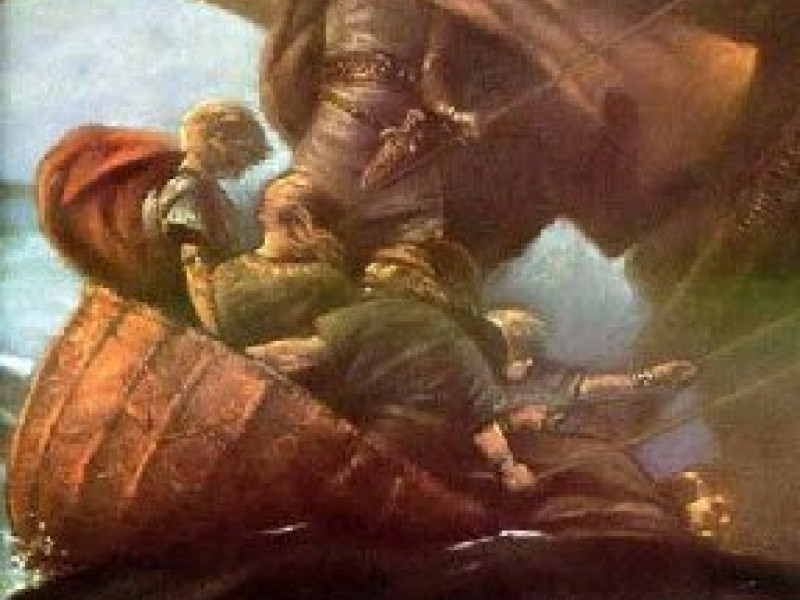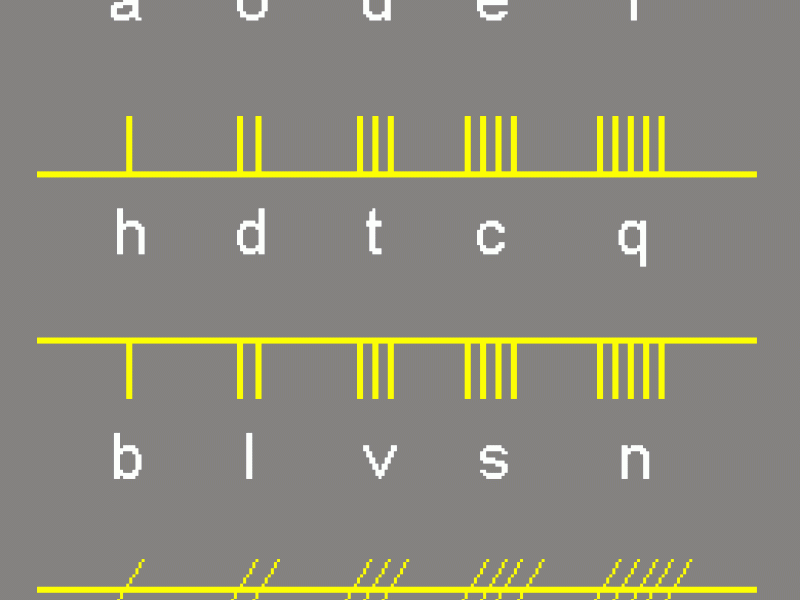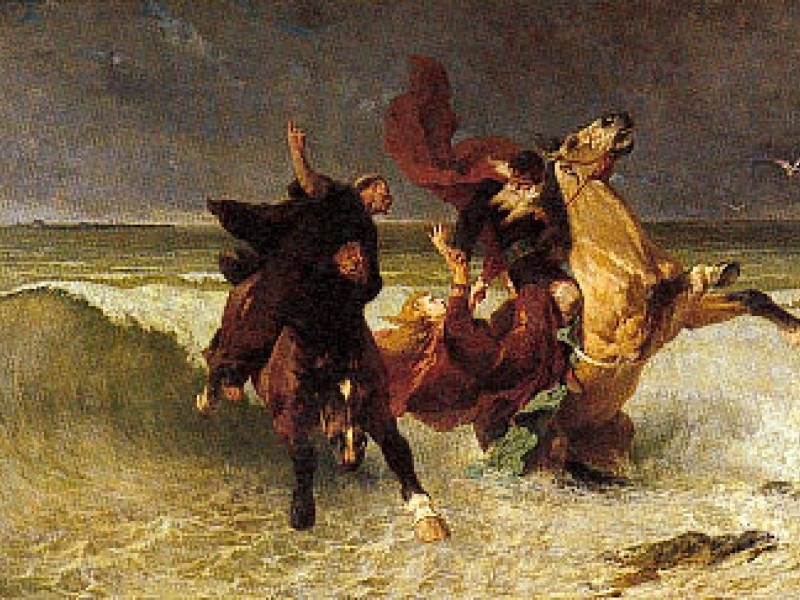Armorican Connections
Armorican Connections looked into the legend in Brittany.
Background

Ancient Armorica
During the classical period, the Romans gave the name of the peninsula in Brittany as Armorica. The coastal peninsula that jutted out of ancient Gaul (France) in the Atlantic Ocean had strategic importance to the Romans, because it would give them naval control over the Atlantic and the English Channel. So when Gaius Julius Caesar (100-44 BC) embarked on a conquest of Gaul (59-50 BC), he set about occupying the Armorican peninsula in 56 BC. This was before Caesar's first campaign into Britannia (Britain).
The Celts had arrived in Gaul and possibly settled in this peninsula as early as the 6th century BC. Armorica (Brittany) was inhabited at that time by several Celtic tribes, the best known of which was the Veneti. The other Armorican tribes included the Coriosolites, Essuvii and Osismi. The Veneti tried to resist Caesar's legions.
At first, the Veneti were quite successful because they had island strongholds around Brittany. When one stronghold was threatened, they evacuated the island and moved to another stronghold. This frustrated Caesar, who was forced to take the next island. So Caesar had to build a navy for the strong tides of the Atlantic. Once the Romans conquered the Veneti, it paved the way for Caesar's brief campaigns in Britain. Armorica was the last region in Gaul to fall to Caesar. Armorica, like the rest of Gaul, became part of the Roman province (Gaul Lugdunensis), but unlike the rest of the Gallic provinces, Armorica was never fully Romanized, retaining strong Celtic culture and customs.
There is not much written information about Armorica after the region became part of the Roman province of Gaul Lugdunensis.
When the the Roman Empire was weakened by a series of civil wars, rebellions and the barbarians encroaching on their frontiers between 3rd and 5th centuries AD, Armorica was able to regain some sort of independence.
Armorica was the last Celtic frontier in Gaul. The Visgoths took the southern part of Gaul, while the Franks settled in the northern part of Gaul. In the east, the Burgundians occupied the area around the Rhine valley.
With the invasion of the province of Britannia (Britain) by the Angles and Saxons during the 5th and 6th centuries AD, many of the Britons fled across the English Channel to Armorica, seeking refuge. The name Armorica was changed to Brittany, which means "Little Britain", as opposed to Great Britain of the British Isles.
Today, the Welsh and Breton languages are not mutually comprehensible, though the two languages were historically linked because of the migration of the Britons. During the late 12th century, a traveller named Giraldus Cambrensis had remarked that Breton was closer to the now extinct Cornish, than to Welsh.
Despite, the linguistic difference between the two peoples, Wales and Brittany were definitely linked culturally and by their oral traditions. Their legends and folklore were closer as we can see in the legend of Tristan and King Arthur. However, I am not going to discuss Arthur and Tristan in this article.
(Please note that I have been informed by one of my visitors that some archaeologists and linguists believed that the Veneti were not Celtic; instead, they were people who spoke an ancient form of Slavic language, according to inscriptions found on some stones, known as Toponyms. Some of the Veneti names found seem to resemble names from a language spoken in Slovenia. Caesar sometimes referred the Veneti as Gauls, so most people would assume that they were a Celtic tribe. I had not taken the time to investigate this yet, so I don't know whether this is true.)
Related Information
Name
Armorica – "seaside" (Latin).
Brittany, Little Britain.
Bretagne (modern French).
Breiz (modern Breton).
Sources
Gallic Wars was written by Julius Caesar, in 46 BC.
Oral Tradition and Writing
The people of Brittany (Armorica) used a Celtic language called Breton. Breton belonged to the Brythonic branch or family of languages (also known as P-Celtic), like Welsh and Cornish (now extinct). Brythonic was the language of the "Britons". The other Celtic family was called Goidelic (also known as Q-Celtic), which was and is the language of the "Gaels", including the Irish, Scottish Gaelic and Manx.
Although Breton was related to Welsh and Cornish, Breton had become incomprehensible to the other two languages in Britain. This was mainly due to regional influences from the Old French language over an extended period of time.
There are a small number of medieval Breton lais or "lays" that have survived, but not in Breton. These are only extant in translations or adaptations in French or English. Contemporary historians like Giraldus Cambrensis have praised the professional singers and storytellers in Brittany, yet nothing survived in writing from this period. The only Breton literature that has survived, comes from no earlier than 1450.
A French poetess named Marie de France who flourished in the mid-12th century said that she had translated some Breton songs or poems into Old French (in the Anglo-Norman dialect). One lai has an Arthurian background, which was titled Lanval. The other is a treatment of the Tristan legend called Chevrefoil ("The Honeysuckle").
But what we do know of the Breton storytellers has greatly enriched the Celtic folklore and the Arthurian literature.
Take the Arthurian literature, for example. Geoffrey of Monmouth and a number of other writers wrote how Arthur fell in battle. Geoffrey, who relied on Welsh sources of the battle, also relied on Breton oral traditions. Although he was born in Wales, Geoffrey's parents were most likely of Breton descent. Geoffrey travelled to Brittany and Rome before he became the bishop of St. Asaph.
None of the Welsh sources showed that Arthur lived beyond his final battle in Camlann. Geoffrey wrote that Arthur was taken to Avalon to be healed, where he waited for a time before he would return when Britain was in great need. Most scholars believe that the belief that Arthur was still alive in Avalon came from Breton tradition, not Welsh.
I have already talked about the Celtic romance of Tristan, here and on the Tristan page. By the time the Tristan legend was fully developed, about 1150, the archetypal poem was developed by Breton tradition, which the earliest French poets, Beroul and Thomas, relied upon when they wrote their own narratives.
Also we can't discount the number of medieval writers from all over Europe who claimed to have used Breton sources for their own materials.
Submerged Cities
Breton Songs
As I had said in Oral Tradition and Writing (Background), there's no Breton literature that have survived the medieval period. Most of what we know about Breton legend comes from the French and English writers who used and translated the songs sung by Breton storytellers into their own languages.
A number of famous writers had testified of the great skills of the Breton singers or storytellers, known as trouvères. They were like the Provençal troubadours from southern France. They recited songs or poems which were accompanied by music, all from memory and practice.
Some medieval writers claimed that their sources for the legend of Arthur came from not Wales, but Brittany.
The Anglo-French poetess Marie de France (flourished between 1160-1180) claimed that she had faithfully translated a number of lais into French.
By Jimmy Joe







